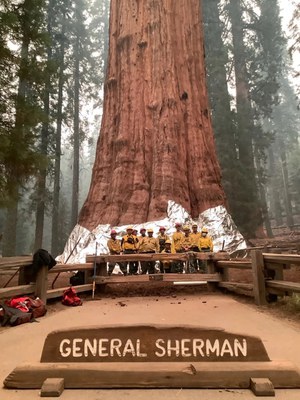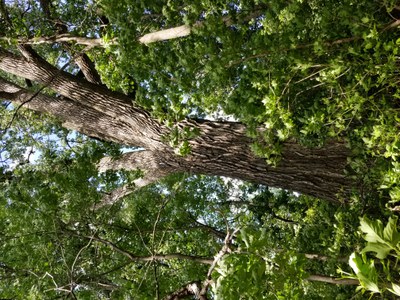Veterans and Veteran Trees

- General Sherman was covered in fire-resistant aluminum by firefighters, to protect him from the devastating wildfires of 2021. Credit: NPS
Veteran’s Day is observed on November 11 – to commemorate the end of WWI at 11am on November 11, 1918. The day honors (and justly so) all of America’s veterans for their patriotism, love of country, and willingness to serve and sacrifice for the common good.
In addition to those who have selflessly served our country, the word ‘veteran’ can be used to describe someone (or something) with long experience in an occupation or skill. Let’s talk about “Veteran Trees” – trees with historic significance or those that have lived a long life of service, gracing our surroundings with natural beauty.
The most familiar big, old trees are the sequoias and redwoods of Northern California. Giant sequoias are recognized by their orange-red thick bark that is up to 18 inches thick, providing protection from burning and the heat of forest fires. During the ravaging 2021 fires in California, a fire-resistant aluminum blanket was used to protect the base of General Sherman, the world’s largest tree (by volume) at 275 feet tall and a basal circumference of 103 feet. Interestingly, the seeds of sequoia, which are the size of a grain of oatmeal, must fall on bare mineral ground to germinate – soil made bare by fire. Giant sequoias are adapted to periodic fire. General Sherman is estimated to be 2,500 years old while some sequoias in the Sierra Nevada Mountains of California are likely closer to 3,000 years old.
Coast redwoods grow taller than sequoias, with the champion measuring 390 feet tall – that’s more than a football field’s length! It’s the coastal conditions with substantial rainfall in spring, fall and winter – along with foggy conditions common along the northern Pacific coast – that provide ideal conditions for these trees to grow to such a massive size.
The oldest trees in the world are Great Basin Bristlecone pines, found in the White Mountains of California in Great Basin National Park. These trees grow at high elevations with harsh growing conditions: a short growing season, below-freezing temperatures and high winds which form a gnarled trunk. The growing conditions result in a very slow growth rate, resulting in very dense wood which makes the trees resistant to insects, fungi, and rot. They grow in a substrate of limestone rock where no other vegetation will grow, making them an isolated species where there is little danger of a forest fire. The US Forest Service has allowed coring a few of these trees to determine their age by counting tree rings. In 2012, one tree was dated at over 5,000 years old.
North Dakota is home to some veteran trees, too. Petrified forests occur in the southwestern corner of the state, most notably in the South Unit of Theodore Roosevelt National Park. A walking trail guides you to spectacular close-up views of the petrified remains of sequoia trees which once stood 100 feet tall and 12 feet in diameter. These tree stump remains are 60 million years old.
Take time to appreciate nature’s veterans. Check out the ND Forest Service Register of Champion Trees. This register is the official list of the first and second largest trees of each native and non-native species in the state. The largest tree in North Dakota is a native cottonwood located in rural Cass County, standing 123 feet tall with a circumference close to 30 feet.
Take time to acknowledge and thank our brave military veterans – and remember those who gave the ultimate sacrifice.
By Gerri Makay, NDFS Community Forestry Manager



